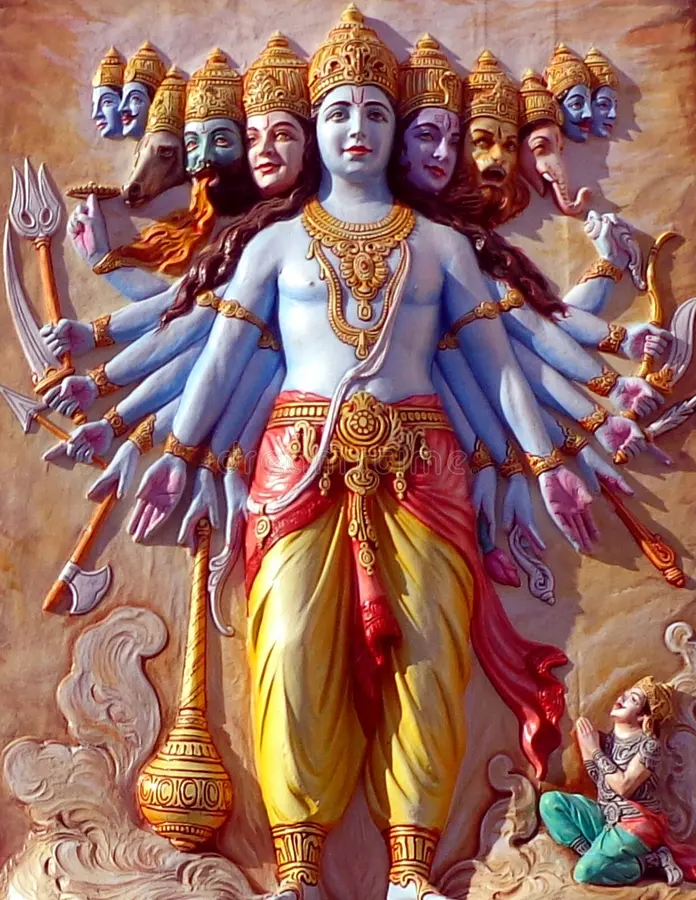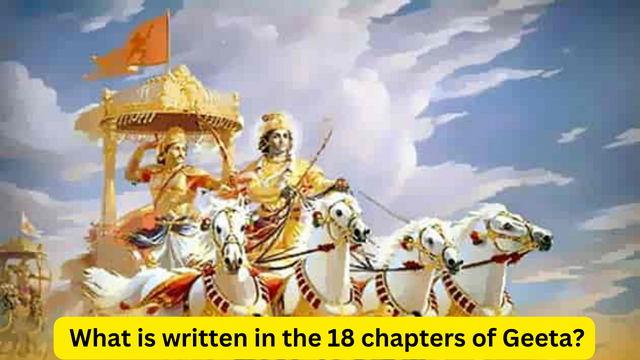The religious scriptures of Hindus are the four Vedas, the essence of the Vedas is the Upanishads and the essence of the Upanishads is the Geeta. Geeta is the essence of all the scriptures. That is why Srimad Bhagavad Gita is the most respected book of Hindus. It can also be called the pocket version of Vedas and Upanishads. Bhagwat Geeta is also a part of Bhishma Parva, one of the 18 chapters of Mahabharat. Geeta also has a total of 18 chapters. The total number of verses in 18 chapters is 700. Let us know what is written in the 18 chapters of Geeta.

The first chapter is Arjunavishadayoga
In this chapter, both the armies Pradhana, enumeration of brave men, statement of Samarthya, and sound of the conch is depicted.. The incident of the army-free moment and the fascination of seeing my brothers and sisters standing in front of me. These are the words full of Arjun’s cowardice, affection, and show. In this Arjun says that even if I achieve victory by killing my brothers, then it will not be happiness for me. I will regret it.
Second chapter named Sankhyayoga
In this Shri Krishna says that it is not appropriate to talk about this at this time, because war has already been imposed on us. Now if you don’t fight, you will die. When Arjun says that he should leave the war by all means. Then Shri Krishna says that turning away from the war now is impotence and cowardice. In this discussion, Shri Krishna tells Arjun about the immortality of the soul and says that the soul can never be killed and the person you are talking about grieving over whose death is his body. Because of this, you will die if not today or tomorrow. That’s why don’t consider Loss or win profit or loss and happiness-sorrow as equal, after that get ready for war. In this chapter, Shri Krishna describes the characteristics of a man with numerical and stable intelligence.
The third chapter is named Karmayoga
Advertisement
In this, the superiority of doing the prescribed work with a dispassionate attitude in the life of the Lord has been described as per the principles of Gyaanayoga and Karmayoga. In this, a serious analysis of karma has been done. The symptoms of ignorance and knowledge- Havana and the inspiration for doing work by being free from passion. And hatred have been talked about. The essence of the principle of karma of the Hindu religion is written in this chapter itself. From this, it becomes clear that the Hindu religion is a religion of Karmavadi and not Bhagyavadi. Sri Krishna says that in reality the entire karma is performed in all respects by the modes of nature, which is a series of actions and causes.
Fourth Chapter is Gyankarma Sannyasayoga
It describes Gyan, Karma, and Sannyasa Yoga. The effect of Saguna Bhagawan and the subject of Karmyoga. The conduct of Yogi Mahatma men and their glory, the description of different yagyas along with their results, and the glory of knowledge have been described.
The fifth chapter is called Karmasanyasyoga.
In this, the decision of Sankhyayoga and Karmayoga, characteristics of Sankhyayoga and Karmayoga and their glory, subject of Jnanayoga, and description of Dhyanayoga including devotion have been described. In the description of all the above Yogas, there is a description of Adhyatma, Ishwar, Moksha, Atma, Dharma Niyam, etc., and not for any kind of war or war.
Sixth Chapter is Aatmasanyas Yoga
In this, the subject of Karmayoga and the characteristics of an orthodox man, the inspiration for self-salvation and the characteristics of a God-realized man, a detailed description of Dhyana Yoga, the subject of the Nigrahas of the mind is given. The theme of man’s movement and the glory of Dhyanayogi have been described.
Seventh Chapter is Gyan Vigyan Yoga
In this, the subject of knowledge including science, statement of God’s omnipresence causally throughout all matter. Demonic nature and criticism and praise of devotees of God, not knowing the effect and form of God. The condemnation of those who know and the glory of those who know have been described.
The eighth chapter is named Yaakshar Brahmayoga
In this Brahma, Adhyatma, and Karmadi gyan is given. The subject contains seven questions of Arjuna and their answers given by Shri Krishna. The subject of Yoga and the secrets of Shukla and Krishna’s path are described.
The ninth chapter is named Rajavidyarajaguhyayoga
It is the subject of knowledge including influence. It discusses the relationship of the world with God and the elements of nature. In this, the subject of the origin of the world, the condemnation of those of demonic nature who blaspheme God. And the nature of worshiping God of those of divine nature, description of the form of God including his supreme influence, Sakam, and Nishka describe the fruit of Upasana and Nishka describes the glory of devotion to God.

The tenth chapter is named Vibhuti Yoga
This includes the description of Lord Krishna’s Vibhuti and Yogashakti and the result of knowing him. The statement of Bhakti Yoga along with its results and effects, Arjuna’s praise of Lord Krishna and prayer to express his Vibhuti and Yogashakti. Krishna descriped his divine powers and yogic powers. Vibhuti means accomplishments and powers.
The eleventh chapter of Geeta is Vishvarupdarshanyoga
This includes Arjun’s prayer to see the universal form, Bhagawan’s description of his universal form, Sanjay’s description of the universal form towards Dhritra, and Arjun’s desire to see Krishna form of the universe and praise him. Lord Krishna’s description of his influence and enthusiasm for the battle by Arjuna. Frightened Arjuna’s praise of Lord and prayer for seeing him in his four-armed form. There is a description of the glory of the darshan of Vishwarupa and whether the four-armed and hundred face form can be seen or not. The rarity of seeing the four-armed form without exclusive devotion and the description of exclusive devotion along with its results.
The twelth chapter is named Bhakti Yoga
In this, there is a judgment about the excellence of the worshipers of Sakarra and Nirakara and the description of the steps to attain God and in it, the characteristics of God-realized men have been described.
Thirteenth Chapter is Kshetra-Kshetragyavibhagyog
What is the description of the subject of and what is the detailed description of the subject of nature-man including knowledge? That is, there is mysterious knowledge of state, knowledge, soul, supreme soul, and five elements.
The fourteenth chapter of Geeta is Gunatrayavibhagyoga
It describes the glory of knowledge and the origin of the world from nature. There is a detailed analysis of the subject of Sat, Raja, and Tam – the three gunas. Apart from this, the degree and quality of attaining Godliness have been described as the characteristics of a man with great qualities.
The fifteenth chapter is named Puruso Tammyoga
In this, the ways of attaining God have been described by describing the world as an inverted tree. In this, there is a detailed description of the subject of the living soul and the form of God along with its effects. And there is also a detailed description of the subject of Kshar, Akshar, Purushottam.
The sixteenth chapter is from the name Daiva Surasampadvibhagayoga
In this, divine and demonic persons and properties along with their results have been mentioned. You will also get a description of the symptoms of people with demonic possession and their downward path. Apart from this, inspiration has been given to abandon the conduct not tested by the scriptures .And to behave according to the scriptures.
Seventeenth Chapter is Shraddhatrayavibhag Yoga
It describes the subject of faith and those who perform severe penance as per the scriptures. In this, different types of diet, yagya, penance, and charity have been explained. Apart from this, the use of Om Tatsat has been explained.
The eighteenth chapter is named Mokshasanyasyoga
In this, there is a detailed description of renunciation, a statement of Sankhya’s theory in the occurrence of actions, and a description of different types of knowledge, action, doer, intelligence, attachment, and happiness according to the three gunas, varnas including results. There is a description of the subject of religion, a description of knowledge and belief. A discussion of the actions including devotion, and finally a description of the martyrdom of Srigita Ji.

